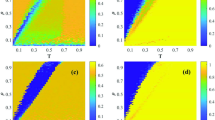Abstract
We study the behaviour of a Schelling-class system in which a fraction f of spatially-fixed switching agents is introduced. This new model allows for multiple interpretations, including: (i) random, non-preferential allocation (e.g. by housing associations) of given, fixed sites in an open residential system, and (ii) superimposition of social and spatial mobility in a closed residential system. We find that the presence of switching agents in a segregative Schelling-type dynamics can lead to the emergence of intermediate patterns (e.g. mixture of patches, fuzzy interfaces) as the ones described in [E. Hatna, I. Benenson, J. Artif. Soc. Social. Simul. 15, 6 (2012)]. We also investigate different transitions between segregated and mixed phases both at f = 0 and along lines of increasing f, where the nature of the transition changes.
Similar content being viewed by others
References
T.C. Schelling, J. Math. Sociol. 1, 143 (1971)
H. Meyer-Ortmanns, Int. J. Mod. Phys. C 14, 311 (2003)
D. Vinković, A. Kirman, Proc. Natl. Acad. Sci. 103, 19261 (2006)
D. Stauffer, S. Solomon, Eur. Phys. J. B 57, 473 (2007)
K. Müller, C. Schulze, D. Stauffer, Int. J. Mod. Phys. C 19, 385 (2008)
M.A. Sumour, A.H. El-Astal, M.A. Radwan, M.M. Shabat, Int. J. Mod. Phys. C 19, 637 (2008)
L. Gauvin, J. Vannimenus, J.-P. Nadal, Eur. Phys. J. B 70, 293 (2009)
L. Gauvin, Modélisation de systèmes socio-économiques à l’aide des outils de physique statistique, Ph.D. thesis, Université Pierre et Marie Curie, 2010
T. Rogers, A.J. McKane, J. Stat. Mech. 2011, p07006 (2011)
S. Grauwin, F. Goffette-Nagot, P. Jensen, J. Publ. Econ. 96, 124 (2012)
W.A.V. Clark, M. Fossett, Proc. Natl. Acad. Sci. 105, 4109 (2008)
A. Pluchino, C. Garofalo, A. Rapisarda, S. Spagano, M. Caserta, Physica A 390, 3944 (2011)
A. Pluchino, A. Rapisarda, C. Garofalo, Physica A 389, 467 (2010)
A.E. Biondo, A. Rapisarda, C. Garofalo, Physica A 390, 3496 (2011)
A.E. Biondo, A. Pluchino, A. Rapisarda, D. Helbing, PLoS ONE 8, e68344 (2013)
D. Cornforth, D.G. Green, D. Newth, Physica D 204, 70 (2005)
G. Deffuant, F. Amblard, G. Weisbuch, T. Faure, J. Artif. Soc. Social. Simul. 5, 1 (2002)
E. Hatna, I. Benenson, J. Artif. Soc. Social. Simul. 15, 6 (2012)
T.C. Schelling, Micromotives and Macrobehavior (W.W. Norton, New York, 1978)
F.L. Jones, Aust. New. Zealand J. Sociol. 21, 431 (1985)
M. Blume, V.J. Emery, R.B. Griffiths, Phys. Rev. A 4, 1071 (1971)
T. Rogers, A. McKane, Phys. Rev. E 85, 041136 (2012)
M.N. Barber, in Phase Transitions and Critical Phenomena, edited by C. Domb, J.L. Lebowitz (Academic Press, New York, 1983), Vol. 8, p. 145
K. Binder, Rep. Prog. Phys. 50, 783 (1987)
L. Gauvin, A. Hazan, J. Randon-Furling, ECCS’13 (selected for oral presentation)
S. Grauwin, E. Bertin, R. Lemoy, P. Jensen, Proc. Natl. Acad. Sci. 106, 20622 (2009)
J. García-Ojalvo, J. Sancho, Noise in Spatially Extended Systems (Springer-Verlag, New York, 1999)
W.A.V. Clark, Demography 28, 1 (1991)
A.J. Laurie, N.K. Jaggi, Solid State Phys. 45, 183 (2002)
M. Fossett, J. Math. Sociol. 30, 185 (2006)
I. Benenson, Comp. Env. Urb. Syst. 22, 25 (1998)
C. Schulze, Int. J. Mod. Phys. C 16, 351 (2005)
I. Benenson, I. Omer, E. Hatna, Environment and Planning B 29, 491 (2002)
E.E. Bruch, R.D. Mare, Am. J. Sociol. 112, 667 (2006)
G. Koehler, J. Skvoretz, Soc. Sci. Res. 39, 14 (2010)
D. Stauffer, J. Stat. Phys. 151, 9 (2013)
Author information
Authors and Affiliations
Corresponding author
Additional information
Both authors contributed equally to this work.
Rights and permissions
About this article
Cite this article
Hazan, A., Randon-Furling, J. A Schelling model with switching agents: decreasing segregation via random allocation and social mobility. Eur. Phys. J. B 86, 421 (2013). https://doi.org/10.1140/epjb/e2013-31142-1
Received:
Revised:
Published:
DOI: https://doi.org/10.1140/epjb/e2013-31142-1




